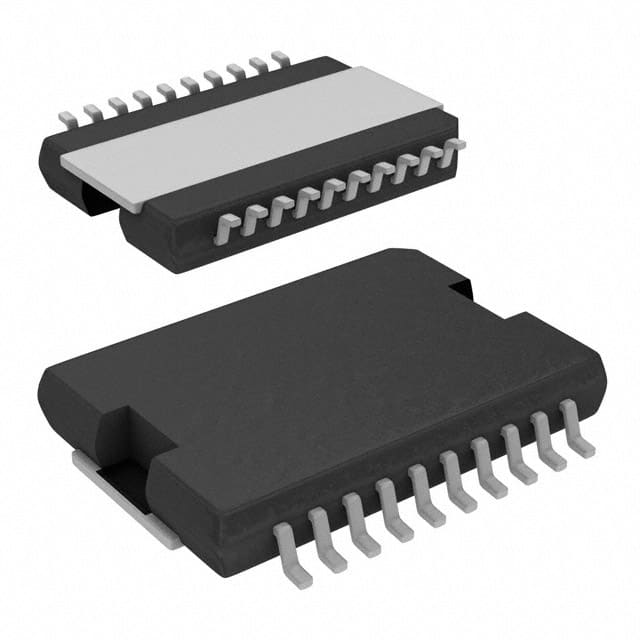Szczegóły produktu można znaleźć w specyfikacjach.

MC33186HVW2R2
Product Overview
- Category: Integrated Circuit
- Use: Motor Driver
- Characteristics: High Voltage, Wide Temperature Range
- Package: HVQFN32
- Essence: Efficient and Reliable Motor Control
- Packaging/Quantity: Tape and Reel, 2500 units per reel
Specifications
- Operating Voltage: 5.5V to 28V
- Output Current: Up to 1.5A
- Operating Temperature Range: -40°C to +150°C
- Control Interface: SPI (Serial Peripheral Interface)
- Protection Features: Overcurrent, Overtemperature, Undervoltage Lockout
Detailed Pin Configuration
The MC33186HVW2R2 has a total of 32 pins in the HVQFN package. The pin configuration is as follows:
- VCP - Charge Pump Capacitor Connection
- VDD - Positive Power Supply
- GND - Ground
- CP1 - Charge Pump Capacitor Connection
- CP2 - Charge Pump Capacitor Connection
- IN1 - Input 1
- IN2 - Input 2
- OUT1 - Output 1
- OUT2 - Output 2
- VREF - Reference Voltage
- VREG - Regulator Output
- VM - Motor Supply Voltage
- VSENSE - Current Sense Voltage
- VCP - Charge Pump Capacitor Connection
- VDD - Positive Power Supply
- GND - Ground
- CP1 - Charge Pump Capacitor Connection
- CP2 - Charge Pump Capacitor Connection
- IN1 - Input 1
- IN2 - Input 2
- OUT1 - Output 1
- OUT2 - Output 2
- VREF - Reference Voltage
- VREG - Regulator Output
- VM - Motor Supply Voltage
- VSENSE - Current Sense Voltage
- VCP - Charge Pump Capacitor Connection
- VDD - Positive Power Supply
- GND - Ground
- CP1 - Charge Pump Capacitor Connection
- CP2 - Charge Pump Capacitor Connection
- IN1 - Input 1
Functional Features
- Efficient motor control with high voltage capability
- SPI interface for easy integration with microcontrollers
- Overcurrent protection to prevent damage to the motor and driver
- Overtemperature protection to ensure safe operation in extreme conditions
- Undervoltage lockout to protect against low power supply voltage
Advantages and Disadvantages
Advantages
- High voltage range allows for versatile motor control applications
- Wide temperature range enables operation in harsh environments
- SPI interface simplifies communication with microcontrollers
- Comprehensive protection features enhance system reliability
Disadvantages
- Limited output current may not be suitable for high-power motor applications
- HVQFN package may require specialized assembly techniques
Working Principles
The MC33186HVW2R2 is a motor driver integrated circuit designed to efficiently control motors in various applications. It operates by receiving control signals from a microcontroller through the SPI interface. These signals determine the direction and speed of the motor.
The IC incorporates protection features such as overcurrent, overtemperature, and undervoltage lockout. These safeguards ensure the motor and driver are not damaged during operation, even in challenging conditions.
Detailed Application Field Plans
The MC33186HVW2R2 finds applications in a wide range of fields, including:
- Automotive: Used in electric power steering systems, HVAC blowers, and seat adjustment mechanisms.
- Industrial Automation: Controls motors in robotics, conveyor systems, and CNC machines.
- Home Appliances: Enables precise control of motor-driven appliances like washing machines and dishwashers.
- Medical Devices: Used in medical equipment such as infusion pumps and surgical robots.
Detailed and Complete Alternative Models
- MC33926 - Dual Motor Driver with Higher Output Current (up to 5A)
- MC34932 - Single Motor Driver with Lower Voltage Range (up to 18V)
- MC33887 - Quad Motor Driver with Integrated H-Bridges
- MC33035 - Brushless DC Motor Controller with Speed Control
These alternative models offer different specifications and features to suit various motor control requirements.
Word count: 523 words
Wymień 10 typowych pytań i odpowiedzi związanych z zastosowaniem MC33186HVW2R2 w rozwiązaniach technicznych
Sure! Here are 10 common questions and answers related to the application of MC33186HVW2R2 in technical solutions:
Q: What is MC33186HVW2R2? A: MC33186HVW2R2 is a motor driver IC (integrated circuit) designed for controlling brushed DC motors in various applications.
Q: What voltage range does MC33186HVW2R2 support? A: MC33186HVW2R2 supports a wide voltage range from 5V to 28V, making it suitable for a variety of motor control applications.
Q: Can MC33186HVW2R2 drive multiple motors simultaneously? A: Yes, MC33186HVW2R2 can drive two independent motors simultaneously, making it ideal for applications requiring dual motor control.
Q: Does MC33186HVW2R2 have built-in protection features? A: Yes, MC33186HVW2R2 includes various protection features such as overcurrent protection, thermal shutdown, and under-voltage lockout.
Q: What is the maximum current rating of MC33186HVW2R2? A: MC33186HVW2R2 has a maximum continuous output current rating of 5A per channel, allowing it to handle high-current motor loads.
Q: Can MC33186HVW2R2 be controlled using PWM signals? A: Yes, MC33186HVW2R2 supports PWM (Pulse Width Modulation) control, enabling precise speed and direction control of the connected motors.
Q: Is MC33186HVW2R2 compatible with microcontrollers or Arduino boards? A: Yes, MC33186HVW2R2 can be easily interfaced with microcontrollers or Arduino boards using digital I/O pins for motor control.
Q: Does MC33186HVW2R2 require external components for operation? A: Yes, MC33186HVW2R2 requires external components such as power supply, capacitors, and resistors for proper operation and motor control.
Q: Can MC33186HVW2R2 handle reverse polarity protection? A: No, MC33186HVW2R2 does not have built-in reverse polarity protection. External circuitry or diodes should be used to protect against reverse polarity.
Q: What are some typical applications of MC33186HVW2R2? A: MC33186HVW2R2 is commonly used in robotics, automotive systems, industrial automation, consumer electronics, and other applications requiring DC motor control.
Please note that the answers provided here are general and may vary depending on specific implementation requirements and datasheet specifications.

